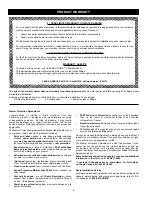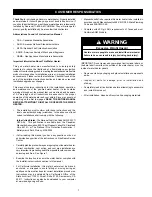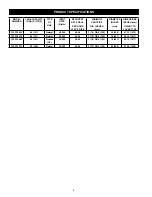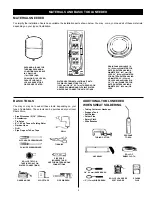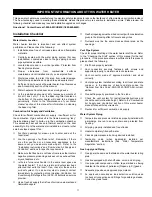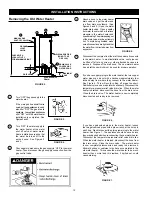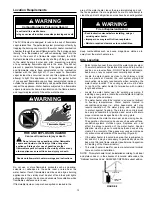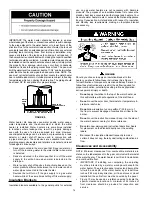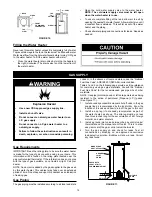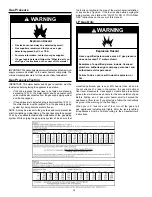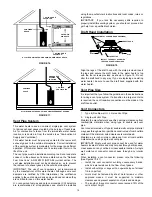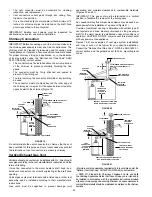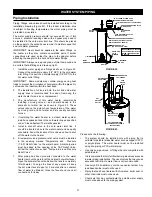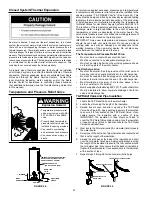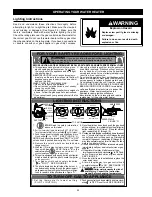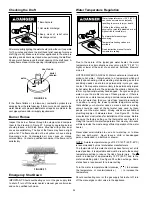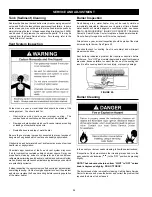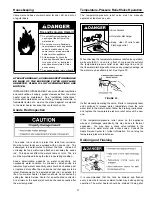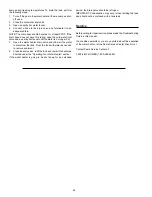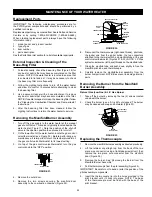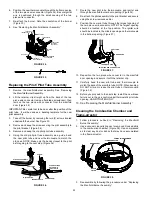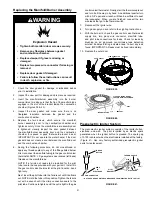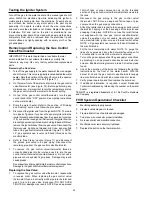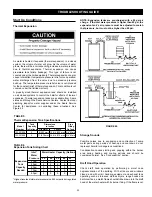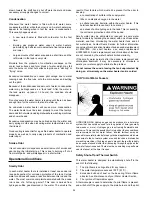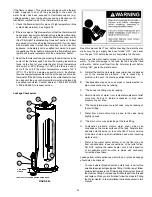
20
separation, and maintain clearances to combustible materials
(Figures 20 and 21).
IMPORTANT: This gas vent must be terminated in a vertical
position to facilitate the removal of the burnt gases.
An unused chimney flue or masonry enclosure may be used as a
passageway for the installation of a gas vent (Figure 21).
Common (combined) venting is allowable with vertical type B
vent systems and lined masonry chimneys as long as proper
draft for the water heater is established under all conditions of
operation. CAUTION: DO NOT common vent this water heater
with any power vented appliance.
Figures 19-21 are examples of vent pipe system installations
and may or may not be typical for your specific application.
Consult the “National Fuel Gas Code”, NFPA 54, ANSI Z223.1-
current edition and the guidelines set forth by prevailing local
codes.
VERTICAL GAS VENT SYSTEM WITH
TYPE B DOUBLE WALL VENT PIPE.
3 FT. MINIMUM
LISTED VENT CAP
2 FT. MINIMUM ABOVE ANY OBJECT
WITHIN 10 FT. HORIZONTALLY
TYPE B DOUBLE
WALL VENT PIPE
**MAINTAIN
SPECIFIED
CLEARANCE
VENT
CONNECTOR
SLOPE UP
1/4 IN. PER FT.
MINIMUM
*MAINTAIN
CLEARANCE
SUPPORT
STRAP
FIGURE 20.
VENTING THROUGH A CHIMNEY WITH
TYPE B DOUBLE WALL VENT PIPE.
5 FT. MINIMUM
LISTED VENT CAP
VENT CONNECTOR
UNUSED CHIMNEY
FLUE OR MASONRY
ENCLOSURE
SEAL
*MAINTAIN
CLEARANCE
VENT
CONNECTOR
SLOPE UP
1/4 IN. PER FT.
MINIMUM
**MAINTAIN
SPECIFIED
CLEARANCE
SUPPORT
STRAP
FIGURE 21.
* Maintain vent pipe clearance requirements to local, state and/or the
“National Fuel Gas Code”, ANSI Z223.1(NFPA 54)-current edition.
** NFPA 211, Standard for Chimneys, Fireplaces, Vents, and Solid
Fuel-Burning Appliances states that these chimneys are intended to
be installed in accordance with the installation instructions provided
with each chimney support assembly. Minimum air space clearance to
combustible materials should be maintained as marked on the chimney
sections.
• The vent connector must be accessible for cleaning,
inspection, and replacement.
• Vent connectors cannot pass through any ceiling, floor,
firewall, or fire partition.
•
It is recommended (but not mandatory) that a minimum 12
inches of vertical vent pipe be installed on the draft hood
prior to any elbow in the vent system.
IMPORTANT: Existing vent systems must be inspected for
obstructions, corrosion, and proper installation.
Chimney Connection
IMPORTANT: Before connecting a vent to a chimney, make sure
the chimney passageway is clear and free of obstructions. The
chimney must be cleaned if previously used for venting solid
fuel appliances or fireplaces. Also consult local and state codes
for proper chimney sizing and application or, in the absence
of local and state codes, the “National Fuel Gas Code”, ANSI
Z223.1(NFPA 54)-current edition.
•
The connector must be installed above the extreme bottom
of the chimney to prevent potentially blocking the flue
gases.
• The connector must be firmly attached and sealed to
prevent it from falling out.
•
To aid in removing the connector, a thimble or slip joint may
be used.
•
The connector must not extend beyond the inner edge of
the chimney as it may restrict the space between it and the
opposite wall of the chimney (Figure 19).
LISTED LINED
CHIMNEY
2 FT. MINIMUM ABOVE ANY OBJECT
WITHIN 10FT. HORIZONTALLY
DO NOT EXTEND
VENT BEYOND EDGE
OF CHIMNEY
VENT
CONNECTOR
3 FT. MINIMUM
MAINTAIN
CLEARANCE*
SEAL
SLOPE
UP 1/4 IN.
PER FT.
MINIMUM
CHIMNEY TERMINATION VENT SYSTEM
SUPPORT
STRAP
FIGURE 19.
Do not terminate the vent connector in a chimney that has not
been certified for this purpose. Some local codes may prohibit
the termination of vent connectors in a masonry chimney.
Vertical Exhaust Gas Vent
Vertical exhaust gas vents must be installed with U.L. listed type B
vent pipe according to the vent manufacturer’s instructions and the
terms of its listing.
It must be connected to the water heater’s draft hood by a
listed vent connector or by directly originating at the draft hood
opening.
Vertical gas vents must terminate with a listed cap or other roof
assembly and be installed according to their manufacturer’s
instructions.
Gas vents must be supported to prevent damage, joint

